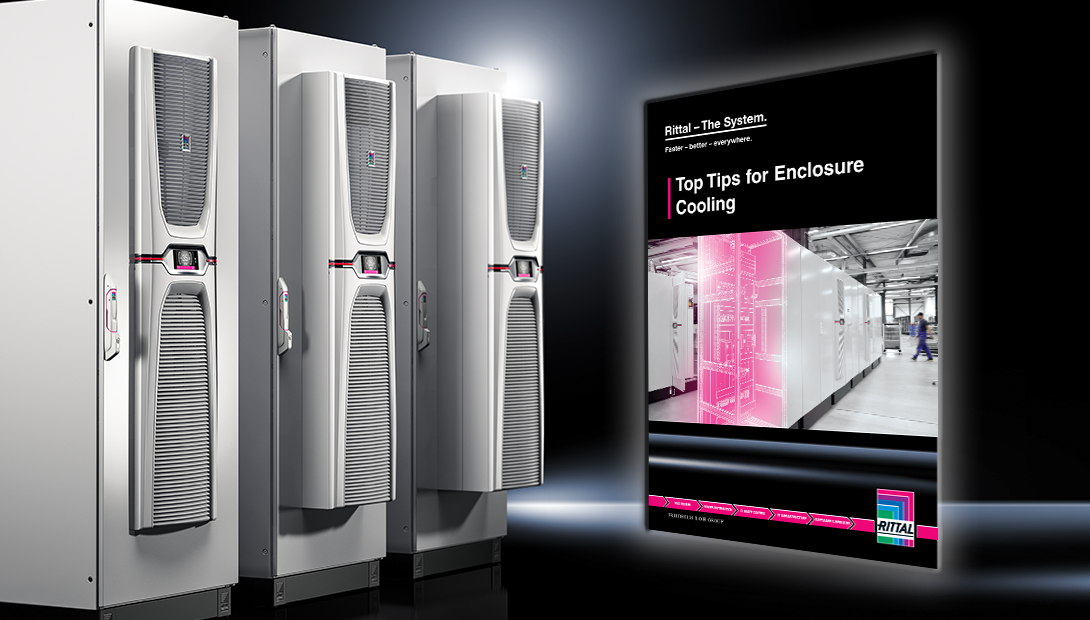
Top tips for enclosure cooling
In these circumstances, the best thing that businesses can do is protect their existing assets. It's fundamentally important to ensure that all assets perform at an optimum level during their entire service life, and for an organisation to continue its journey towards increased efficiency and reliability so that it can remain competitive in a changing marketplace.
In the industrial space, a company’s lifeblood is its machinery and all machinery has critical components such as its electrical drives, motors etc. without which any very expensive robotic arm is nothing but a very elaborate statue, collecting dust. So it’s imperative that electrical equipment is housed within a protective environment, to ensure it operates to its full potential.
A protective environment takes the form of both high quality enclosures and correctly prescribed climate control equipment. The two items work together to safeguard your equipment from the following:
High Temperatures Impact the Lifespan of Equipment
Prolonged high internal temperatures reduce the lifespan of your equipment. This will mean an increased chance of unplanned breakdowns, increased costs and reduced production output.
Furthermore, your equipment cannot work at 100% output once its maximum operating temperature has been exceeded, which means you will experience an overall reduction in your machine’s efficiency and reduced manufacturing output.
To prevent high temperatures being reached within the enclosure, correctly sized enclosure cooling products should be installed. This could be fans and filters, cooling units or air-to-water heat exchangers, dependant on both the amount of heat produced by the electrical equipment and the ambient temperature in the surrounding environment.
Low Temperatures Can Also Damage Equipment
Equipment needs protecting from low temperatures as much as high ones. In winter, when ambient temperatures drop, any equipment that has been idle over the weekend can be damaged as soon as it’s turned on from cold.
In addition, motors or compressors can experience problems when oil contained within sealed systems begins to increase in viscosity. This can damage the seals/components, again causing failures.
To prevent this happening, you should fit a correctly sized enclosure heater inside the enclosure. When connected to a thermostat, the heater will maintain an acceptable minimum temperature preventing any damage to electrical equipment caused when the low temperature minimum is exceeded.
Condensate Poses Safety Risk
Condensate can be a real issue when it forms within the enclosure and on critical equipment in high humidity environments. Condensate poses a real safety risk to the electrical devices and can cause catastrophic failure if left unchecked.
You can combat this problem by using a high quality industrial enclosure with a minimum of an IP54 seal to prevent humid air from constantly entering the enclosure. This can be combined with a cooling unit featuring an integrated condensate evaporator; the cooling unit acts as a de-humidifier and removes excess condensate from the pocket of air within the sealed enclosure.
Dust, Dirt and Corrosive Substances
Many industries suffer from dusty or dirty environments, which can impact on electrical equipment and its optimum performance. For example:
- Carbon dust in the steel or manufacturing industry
- Yeast or vinegar extract in the food and beverage industry
- Salt water vapour in the air in a marine or coastal application
The above contaminants will attack the wires and electrical connections within your enclosure. In time, this can corrode or (worse) short connections, which in turn can cause excess heat and/or a panel fire.
In highly contaminated environments, the best advice is to use a cooling product which does not allow dirty ambient air to constantly enter the enclosure, so fans and filters are a no-no. Air-to-air or air-to-water heat exchangers and cooling units are best solutions, dependant on the heat load as they will only treat the small pocket of air within the enclosure, but they will also reduce the level of contaminants entering the space.
Cooling Top Tips
Any change or upheaval that impacts on a company’s trading environment brings with it challenges, but also opportunities. The trick is always to optimise your business for success, reducing costs wherever possible, while maximising productivity and efficiency.
The long term benefits of maintaining that protective environment and allowing your equipment to perform to its optimum will, in turn, help your business to flourish.
These points and more are covered in Rittal's latest guide, where we look in depth at key considerations you need to make when assessing your site.
Download the guide via the following link:
Keep up to date with all the latest cooling information
In the industrial space, a company’s lifeblood is its machinery and all machinery has critical components such as its electrical drives, motors etc. without which any very expensive robotic arm is nothing but a very elaborate statue, collecting dust. So it’s imperative that electrical equipment is housed within a protective environment, to ensure it operates to its full potential.
Register below to make sure you get all our latest cooling guides, white papers and webcast information.
Register For Cooling Updates Here
Let Rittal help with RiAssure
Rittal can provide you with a free inspection of your current cooling equipment regardless of manufacturer, age or condition. This will then allow us to advise you of any recommended improvements and (critically) confirm whether you are using the correct equipment.
Check out our recent webcast "RiAssure - Are you COOL about the internal temperature of your enclosures?" via the link below or download the RiAssure brochure to find out more on how Rittal can help you with your cooling needs.
To find out more about what RiAssure and how it can help your business download our brochure below:


